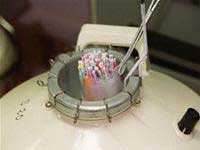Scientists from King’s College London have announced their intention to clone germ cells from rabbit oocytes and human cell nuclei.
 |
|
Freezing Animal Embryos |
Professor Chris Shaw, who leads the research team, stated, “These germ cells are derived from rabbits but are controlled by human DNA and will only be used within the framework of stem cell research and genetic diseases.”
According to UK law, germ cells cannot develop beyond 14 days and cannot be implanted in a woman’s womb. Therefore, Professor Shaw indicated a need to seek alternative sources for producing oocytes.
“The abundant reproductive capacity of rabbits is quite intriguing; we can transfer human cell nuclei into rabbit oocytes,” he explained. “Legally, the situation is still unclear, but there are several points we wish to discuss with the Human Fertilization and Embryology Authority (HFEA) and we hope to receive permission.”
Professor Shaw and his colleagues at King’s College have a collaborative agreement with Professor Ian Wilmut’s team from the Roslin Institute in Edinburgh, Scotland, to clone human germ cells for therapeutic purposes. Professor Wilmut is renowned for creating the first cloned animal, Dolly the sheep, in 1996.
However, the lack of oocytes has posed significant challenges to their research. Currently, their only source is oocytes discarded during in vitro fertilization processes.
Professor Shaw noted that experiments mixing human DNA with rabbit oocytes were conducted by Professor Sheng Huizhen’s team at Shanghai Second Medical University in China in 2004.
This team claims to have produced over 100 viable embryos compatible with the early developmental stage of human embryos (from five to seven days old).
To date, in the UK, only Professor Miodrag Stojkovic’s team at the Institute of Genetics at Newcastle University has successfully created cloned embryos as of May 2005.
H. ĐÀO



















































